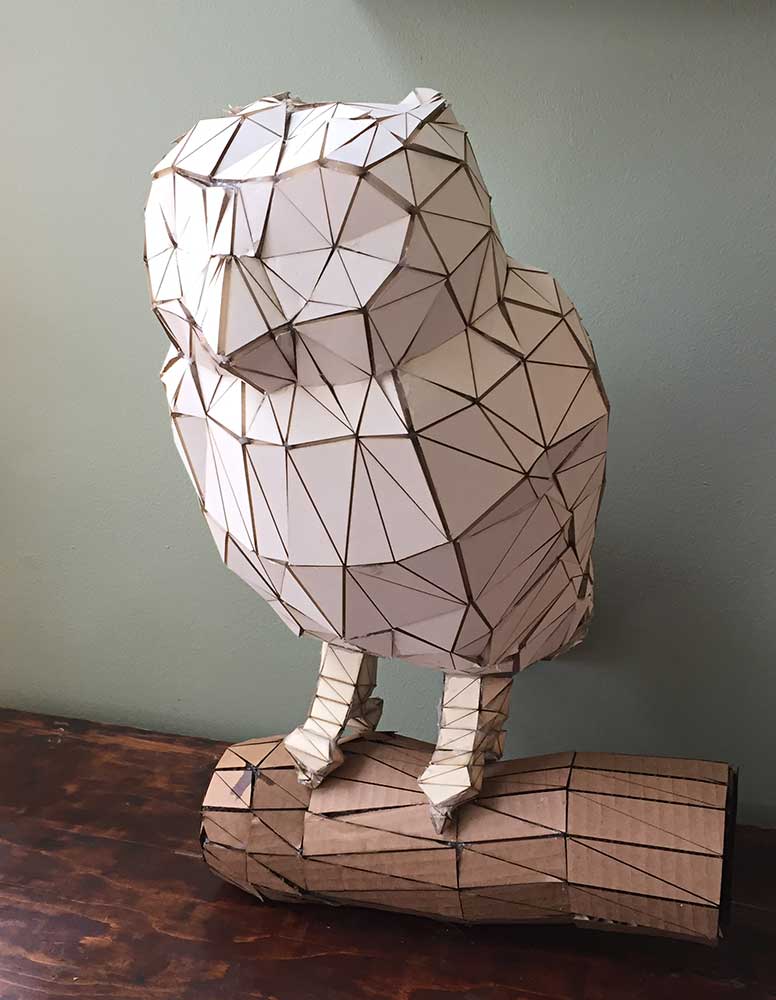I've spent the past several days heat-bending laser cut acrylic into the shape of moth trails (more on that to come)... and at some point, it occurred to me that I have to redesign all of my electronic animals to accommodate a master controller with a custom remote control. I am fatigued by serious engineering and wanting to make more emotional art, but that might not happen for a while longer. Here is an obsolete moth circuit to express my mood.
open studio
Atlas Moth /
Informal studio photos of an Atlas Moth that will fly in my latest Electrolier sculpture.
Low Poly Owl /
I've been working on a series of "low poly" sculptures for my latest Electrolier sculpture. Here are some images of an owl in progress. He was modeled in Blender, unfolded using a research software from a professor at GMU, cut on a laser cutter at Nova Labs, and assembled in my studio. The owl is still in the process of being refined and painted. The image of the pattern corresponds to the owl's right foot. The reason that my Blender model is separated into parts (body + two feet) is related to the pattern's complexity - it's easier to unfold if I process it in pieces.
Embroidering moth wings /
I've been working at Nova Labs in Reston, VA to embroider wings for some of the moths in my new Electrolier sculpture. Here's some informal documentation of my process. The machine is an old industrial "Ultramatic" that was restored by a Nova Labs steward.
I dyed the velvet to give a "loose" colored background that contrasts with the precise stitches. (My registration was off on some of the wings, as you can see if you look closely at the color placement.) I embroidered both sides of the wings, which you can see above prior to assembly of the front and back parts. The middle image shows my "Atlas Moth" circuit board that forms the body -- more on that to come.
Tree cricket prototype /
I'm working on a prototype for a series of tree crickets (for my latest "electrolier" sculpture). This board is a little analog synthesizer with options to adjust resistor and capacitor values, thereby achieving different insect sounds. The video shows only one of the sounds --I'll demonstrate others later.
The wings were laser cut out of Dura-Lar at the Nova Labs Makerspace in Reston, VA. In the video, I'm holding a wire spool to amplify the raw piezo element, for which I need to make a resonant chamber. The piezo is driven with my little "RadioShack copy" amplifier circuit that I blogged about recently (March 12). The board was manufactured in China by PCBWay.
Designing creatures of the night /
Cricket PCB /
My first cricket circuit board arrived today and it chirps!
Astable multivibrator circuit built with discrete transistors. The circuit generates a waveform that sounds like a cricket when applied to a piezo electric buzzer. Kelly Heaton, 2018
I did make one error in my schematic, which involved the reversal of the PNP transistor (3906). Thankfully, the wiring worked perfectly when I turned the PNP in the opposite direction.
Moth Circuit /
I continue to design circuits for the night-dwelling inhabitants of my latest electrolier. Here's a little white moth. It's two wings are separate boards comprising a single functional circuit that I'll join in the middle with wires. Its circuit is an adaptation of the well-known "Knight Rider" design: a 555 timer in astable mode that clocks a 4017 counter. I have selected resistor and capacitor values to blink the LEDs with a flutter effect, and there are several optional inputs to the moth whereby external circuits can add "noise," i.e., random behaviors that give a natural appearance. I will update you when the boards arrive and are wired up... fingers crossed that my design contains no errors, as drawing with copper traces is not the most straightforward way to visualize electrical connectivity. Below are two moth images pulled from the Internet for inspiration, followed by my circuit board design in KiCad software.
Two views of my moth in KiCad. The top image shows a 3d rendering of the actual boards, and the bottom shows my printed circuit board (PCB) layout. Kelly Heaton, 2018



















